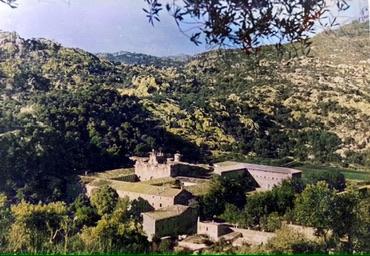What architectural features distinguish the Carthusian Monastery in Valldemossa from other historic buildings on Mallorca?
Similar Topics
carthusian monastery valldemossa
gothic renaissance architecture
mallorca historic buildings
medieval monastic design
cloister courtyard
monastic solitude
sandstone construction
mallorca architectural heritage
The Carthusian Monastery in Valldemossa stands out among Mallorca's historic buildings due to its unique blend of Gothic and Renaissance architectural elements, reflecting its origins in the 14th century. Unlike the island’s typical Mediterranean style characterized by whitewashed stone and simple, rustic forms, the monastery features austere yet elegant stonework, pointed arches, and ribbed vaults that hint at its medieval monastic roots. The layout is centered around a large cloister, a hallmark of Carthusian monasteries, providing a serene courtyard that contrasts with the dense village structures nearby. This arrangement highlights a retreat-like atmosphere, purposefully designed for solitude and contemplation, which is somewhat uncommon for other monastic or civic buildings in Mallorca.
In addition to its structural design, the monastery includes a striking bell tower and fortified walls, which convey both spiritual and defensive functions. The interior spaces are modest but carefully proportioned, with individual cells for monks lining the cloister, each featuring a small garden—an architectural feature that underscores the order’s emphasis on self-isolation within a communal setting. This creates a rhythm and repetition that differ significantly from the island’s parish churches or palaces, which often have more open, grand interior spaces intended for public worship or aristocratic display. Furthermore, the monastery's use of local materials like sandstone ties it visually to the island, yet its overall architectural language remains distinct due to its verticality and geometric precision characteristic of Carthusian orders.
Compared to other historic landmarks on Mallorca, such as the Moorish-influenced Bellver Castle or the Gothic Cathedral of Palma, the Valldemossa Monastery’s design is less ornamental but more introspective. The emphasis on function over form, solitude over congregation, and simplicity over decoration gives it a unique place in Mallorca’s architectural heritage. This makes the Carthusian Monastery not only a rare example of monastic life on the island but also a tranquil haven whose architectural features invite visitors to appreciate a different historical and spiritual dimension of Mallorca’s past.
In addition to its structural design, the monastery includes a striking bell tower and fortified walls, which convey both spiritual and defensive functions. The interior spaces are modest but carefully proportioned, with individual cells for monks lining the cloister, each featuring a small garden—an architectural feature that underscores the order’s emphasis on self-isolation within a communal setting. This creates a rhythm and repetition that differ significantly from the island’s parish churches or palaces, which often have more open, grand interior spaces intended for public worship or aristocratic display. Furthermore, the monastery's use of local materials like sandstone ties it visually to the island, yet its overall architectural language remains distinct due to its verticality and geometric precision characteristic of Carthusian orders.
Compared to other historic landmarks on Mallorca, such as the Moorish-influenced Bellver Castle or the Gothic Cathedral of Palma, the Valldemossa Monastery’s design is less ornamental but more introspective. The emphasis on function over form, solitude over congregation, and simplicity over decoration gives it a unique place in Mallorca’s architectural heritage. This makes the Carthusian Monastery not only a rare example of monastic life on the island but also a tranquil haven whose architectural features invite visitors to appreciate a different historical and spiritual dimension of Mallorca’s past.
🧩 Related Questions
Related Question
How do local businesses and tourism operators promote both sports and cultural activities to improve visitors’ experiences?
Related Question
How does the availability of multilingual signs and menus in Mallorca help tourists navigate language challenges?
Related Question
How does Mallorca’s climate compare to other almond-growing regions in terms of crop success?


